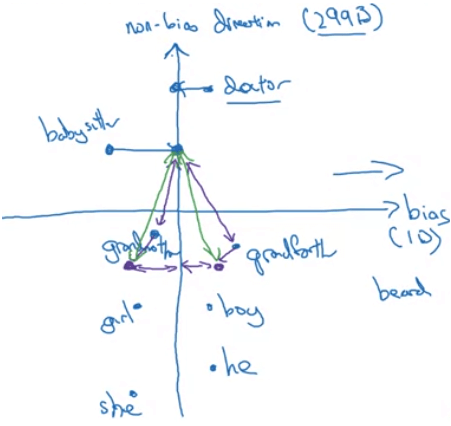NLP and Word Embeddings
本文討論了 NLP 中的 Word Embedding 技術,是一種改良了 one-hot vector 的字詞表示法,將單詞投影到一個高維度空間中的表示方法,讓 model 可以表達出各個字詞之間的關聯性。Word Embeddings 可以使用於 Transfer Learning 來擴大 model 的能力,以及可以執行 Analogy Reasoning 來尋找字詞之間的類似關係。
有許多不同的方法可以訓練一個 word embedding,包括基於頻率的 Count-based 方法,以及以預測 (prediction) 為基礎的 Word2Vec 和 GloVe 等方法。Count-based 方法基於出現次數來算出文字間的相似度,而 Word2Vec 則是利用神經網路來尋找 context/target pairs 之間的關係。
Word Representation
- 還記得我們用 one-hot vector 來表示一個單字
- 假設字典共有 10000 個單字,我們想表達第 i 個單字
- 方法是將 10000 dimensional vector 的第 i 個 entry 設置為 1,其餘為 0
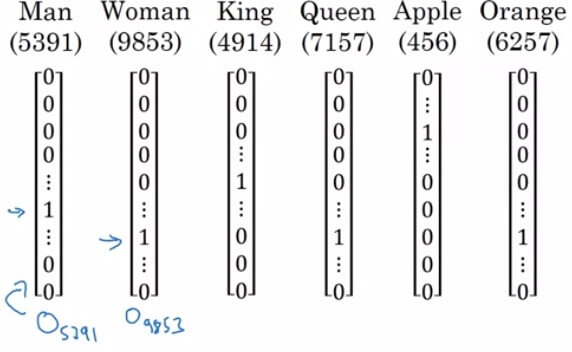
- 假設 Man 在 vector 的第 5391 個 index,我們可以表示成 (O 代表 one-hot)
- 但這方法有一個缺點,就是他無法表達單字之間的關聯性
- 每個字之間的 inner product 都是 0
- 今天我們讓 model 學會預測 orange 後面要接 juice
- 那他能夠預測 apple 後面也應該要接 juice 嗎 ?
- 用 one-hot 肯定是不太行的
Word Embedding (Featurized Representation)
- 我們用各式各樣的特徵來表達一個字
- 跟這個特徵越接近的就設定一個值表示
| Man | Woman | King | Queen | Apple | Orange | |
|---|---|---|---|---|---|---|
| Gender | -1 | 1 | -0.95 | 0.97 | 0.00 | 0.01 |
| Royal | 0.01 | 0.02 | 0.93 | 0.95 | -0.01 | 0.00 |
| Age | 0.03 | 0.02 | 0.7 | 0.69 | 0.03 | -0.02 |
| Food | 0.04 | 0.01 | 0.02 | 0.01 | 0.98 | 0.97 |
| Color | ... | |||||
| Cost | ... | |||||
| Verb | ... | |||||
| ... |
- 假設 Gender, Royal ... 特徵共有 300 個
- 那麼每一個單字,都會是一個 300 dimensional 的 vector
- 用 e 跟 index 組合來表達
- 如此一來,Apple 和 Orange 的 vector 就會非常相似,變得能夠預測 apple juice 了
- 雖然在 color 或一些地方會差異非常多,但無傷大雅
Visualizing Word Embedding
- 有一些算法可以將 word embedding 視覺化,例如 t-SNE algorithm
- 將所有 300 dimensional vector 投影到二維平面
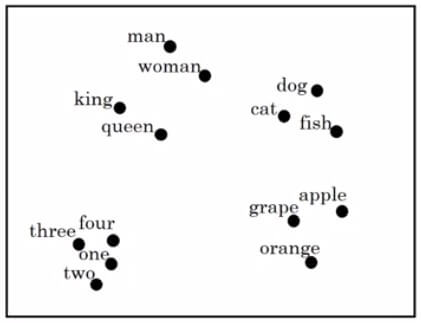
- 可以看到 man 跟 woman 類似所以鄰近
- man, woman, king, queen 為人類所以鄰近
- dog, cat, fish 為生物所以鄰近
- 以上都為生物所以鄰近
- 數字、生物、水果各在一個群體裡面
Why call it Embedding
- 所以到底為什麼把這樣 feature representation 的方式稱作 embedding 呢
- 原因是因為我們把每一個單字 (orange, apple) 各別嵌入 (embed) 到一個非常高維度 (如 300) 的空間中的不同點
Using Word Embeddings
- Word Embeddings 適合應用於 named entity recognition
- 原本要學習上面這個句子時
- Sally 會是一個 one-hot vector
- 並且 output 的 應該會等於 1
- 現在改成用訓練後的 word embeddings 作為 input 來預測下一個句子
- 這時候看到 apple farmer,應該會將 Robert Lin 也預測為人名
- 但若不是 apple farmer 而是 durian cultivator 呢 ?
- 我們可以用 transfer learning 來擴大 word embeddings 的能力
Transfer Learning and Word Embeddings
- 首先要從網路上找出非常大的 text corpus 來訓練 word embedding
- large text corpus = 1 to 100 Billion words
- 或者可以直接下載 pre-trained 的 embeddings
- 接著直接將這個 embeddings 轉移運用到目前 small training set 的 task 上
- small training set = 100k words
- 這就是 transfer learning
- 若是步驟 2 的 training set 蠻大的話,那可以試著用這些 data 來繼續 fine tune 這個 embeddings
- 所以這步驟是 optional
Properties of Word Embeddings
- Word Embeddings 能夠很有效的執行 analogy reasoning
- 例如
mantowomanaskingto ? (queen)

- 假設 embeddings 只有四個特徵
- 用 man 減去 woman 其實就是 gender 的差異
- 而用 king 減去 queen 也會得到差不多的結果
- Analogy reasoning 就是要找到這個 queen 符合
- 所以公式是 : 找到一個 word 滿足下列條件式
- 通常能有 30% - 75% 機率找到最佳解
- 裡面所用到的 similarity function 通常會使用 cosine similarity
- 常見的 analogy reasoning 幫我們找到了以下例子
Man:WomanasBoy:GirlOttawa:CanadaasNairobi:KenyaBig:BiggerasTall:TallerYen:JapanasRuble:Russia
Embedding Matrix
- 最終目標我們要在一個 embedding matrix 上學習 embeddings
- 假設 vocabulary 有 10000 個單字,Embedding 有 300 個特徵
- 那麼就定義一個 的 embedding matrix
- 之後將會隨機初始化 來進行 embedding 的訓練
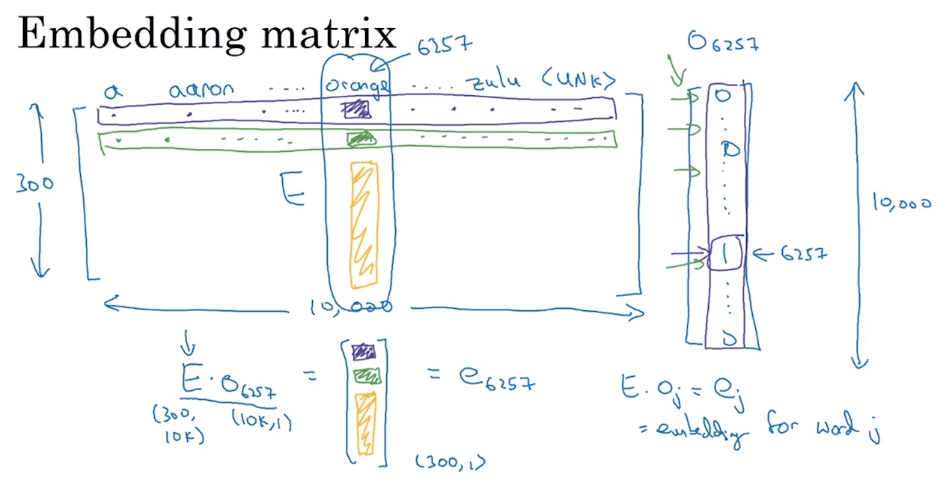
- 我們可以將某一個單字的 embedding 用矩陣相乘方式表達
- 假設要找 orange 的 embedding
- orange 在 vocabulary 中的第 6257 個
- 他的 one hot vector 為
- 所以他的 embedding 等於
- 一般化的表示如圖中右下角所示
- 這只是一個 intuition
- 正常並不會使用矩陣乘法來取得某個 embedding,因為 cost 太高了
- 在實作上,會用一些方式直接取得該單字在 的 column
Learning word embeddings
- 在利用 deep learning 訓練 word embeddings 的歷史上
- 是由複雜的方式慢慢演變為簡單的方式
- 這裡將從複雜但卻直覺的方式開始講起
Neural Language Model
- 在建立預測未知詞的神經網路,就順便可以訓練 embedding matrix
- 首先將每個詞的 one-hot vector 和 embedding matrix 相乘得到 embedding vector
- e.g.
- 接著將這些 embedding vector 丟到 neural network 訓練
- 假設一層 fully-connect 一層 softmax
- 所以共要訓練 這幾個參數
- 假設 embedding 特徵有 300 個,那麼 6 個詞就可以產生 1800 個 inputs
- 首先將每個詞的 one-hot vector 和 embedding matrix 相乘得到 embedding vector
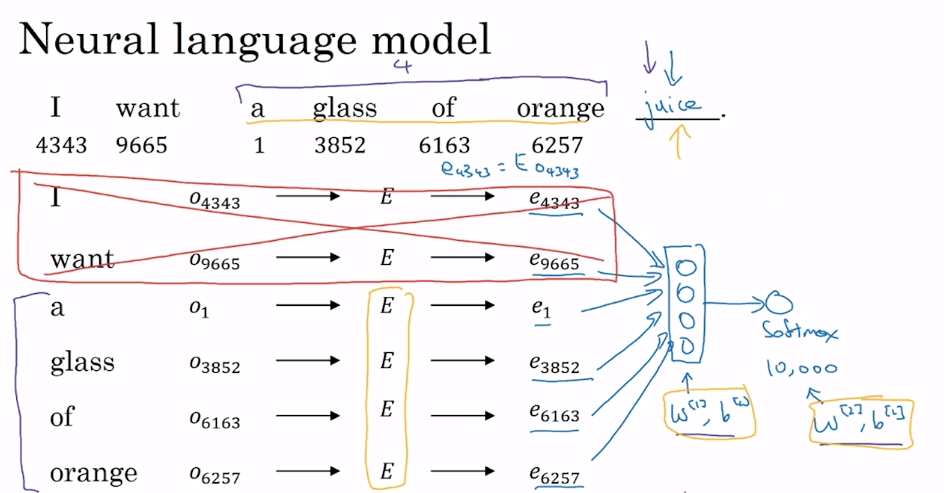
- 在實際應用上,會添加 fixed historical window
- 只抓出預測詞的前 n (e.g. 4) 個字來進行訓練
Other context/target pairs
- 在應用上還有許多 window 大小產生的 context/target pairs
- Last 4 words
- context = a glass of orange
- 4 words on left & right
- context = a glass of orange, to go along with
- Last 1 word
- context = orange
- Nearby 1 word (隨機取周邊的一個單字)
- context = glass
- 這個做法的效果意外的很好
- 是之後的一個方法 Skip-Gram 的 idea
Word2Vec
- Word2Vec 是一種比 neural language model 還要更有效率計算 word embedding 的 algorithm
- Word2Vec algorithm 包含兩種算法
- Skip-gram 從周邊的隨機單字來預測單字
- Continuous Bag of Words 則從上下文來預測單字
- 訓練方法又可分成
- Hierarchical softmax
- Negative sampling
- Word2Vec algorithm 包含兩種算法
Skip-Gram
- 首先要先找出 context word 再來找他對應的 target word
- target 可以選擇是前後五個字、前後十個字的範圍
| context | target |
|---|---|
| orange | juice |
| orange | my |
| orange | glass |
- 看起來是一個很難的 supervised problem
- 但目標不是為了要解 supervised problem 而是要升級我們的 embeddings
Skip-Gram Model
- 假設 Vocab size = 10000, orange = 6257, juice = 4834
- context "orange" , target "juice"
- context, target 皆是 one-hot 型式
- 算出每個 embedding vector 並經由 softmax 來預測
- 前三步驟又可表示為
- 更仔細看 softmax model 他想計算的是
- 在知道 context 情況下 target 的機率
- 其中的 代表跟 output t 有關的 parameter
- 而 表示 vocab 中全部單字的 embedding
- 接著定義一下 softmax 的 cost function
- 是一個 negative log likelihood 的算法
- 於是我們可以訓練 的許多參數 ,以及 softmax 的參數如
Problem with Skip-Gram
- 要計算 softmax 時,需要計算對所有單字求和 (分母部分),計算量非常大
- 有一個解決方法是使用 Hierarchical Softmax Classifier
- 利用樹的方式降低計算時間為 log 時間
- 通常會再使用 Huffman tree 將常用單字編碼在接近 root 的地方
- 有一個解決方法是使用 Hierarchical Softmax Classifier
- 另外要怎麼樣選出 context ?
- 完全隨機 ?
- 那會讓一些單字非常常出現 (e.g. the, and, or, of, a, to, ...)
- 所以一般在實作上,會有一些作法將 apple, orange, durian 這些不常見字和 and, or, are 這些常見字,平均的選取出來,而非完全公平隨機。
- 完全隨機 ?
Negative Sampling
- 為了解決 softmax 運算較慢的問題,作者提出了另一種 negative sampling 的方法
- 我們將原本的 context/target 改變成 context/word/target
- 原本的 context/target 變成 context/word/1 代表 positive example
- 從字典抓出隨機的 word 產生 context/word/0 代表 negative example
- negative example 的筆數為 k 筆
- 作者認為 k 在 large dataset 時以 2-5 筆較佳
- k 在 small dataset 時以 5-20 筆較佳
| context | word | target |
|---|---|---|
| orange | juice | 1 |
| orange | king | 0 |
| orange | book | 0 |
| orange | the | 0 |
| orange | of | 0 |
- 上面是一個 k = 4 的範例
- 這讓我們用另一種方式定義問題,變成解 logistic regression
Negative Sampling Model
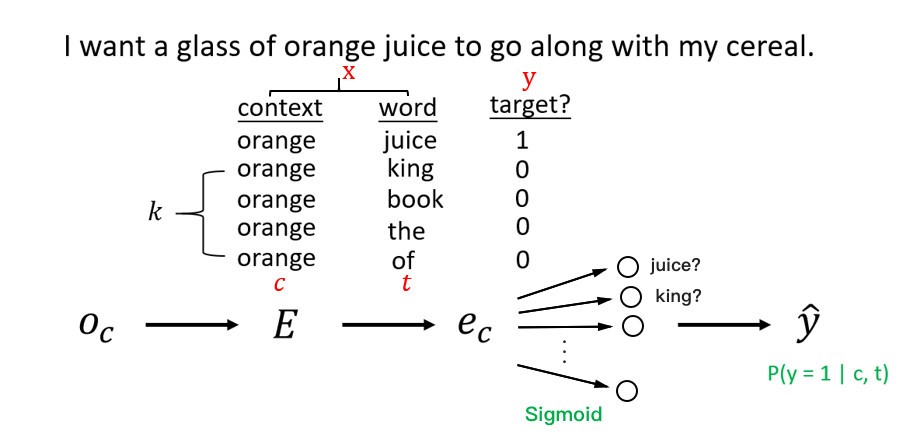
- 現在變成要預測
- 代表給定 context 和 word,是否是正確的關係 (是=1 / 不是=0)
- 計算方法就可以使用簡單的 sigmoid function 來判斷
- 其中的 表示 word 參數, 表示 context 參數
- 畫成 neural networks 的方式來看
- 我們把 orange 作為 one hot vector 計算出 embedding vector
- 然後透過 logistic regression 的方式來訓練每一個結果
- 結果會得到像是訓練出 10000 個 binary logistic regression classifier
- 給定 orange 是 juice 的機率 ?
- 給定 orange 是 king 的機率 ?
- ... (10000 個)
- 但在每個 iteration 的訓練裡,只需要用到 k + 1 筆的 data 來訓練
- 不必像 softmax 每回合的訓練都要重新計算 10000 筆 data
- 關於如何選擇字典的字作為 negative example 的方法
- 作者建議用以下公式作為每個詞被挑選的機率
- 這個公式能增加一些不常見的單字被選中的機率
相關論文
GloVe Word Vector
- GloVe (Global Vectors for word representation)
- 在 GloVe 中一樣有 context/target pairs
- 但改用 表示 context,而 表示 target
- 並且定義 表示 隨著 一起出現的次數 (count)
- 若 "一起出現" 定義為 "出現在前後 10 個單字",那麼有可能
- 若定義為 "出現在下一個字",那麼可能就無法像上面一樣能夠對稱
- 我們將用 來訓練 GloVe Model
GloVe Model
- 定義 Cost function 表示單字間的差異性
- 接著就可以用 Gradient Descent 來最小化
- 其中的 所扮演的角色就像 skip-gram 的 一樣
- 而 則是用來平衡 weights
- 當 為零,log 無法計算時, 就返回 0
- 並且平衡常用字和不常用字出現的權重
- 在 GloVe 算式中的 因為是代表同時出現,所以是對稱的
- 因此訓練後可以取兩個值相加取平均作為共同的值
補充
在實際訓練 Word Embedding 時,算出來的特徵其實超過了人類可以思考的範圍,也就是不能將 vector 解釋成第一個為 gender, 第二個為 royal ...。 但在 analogy reasoning 的部分還是可以很好的呈現!
Sentiment Classification
- 在實際的情感分類應用上,因為 label data 不足,導致訓練成效不佳
- 將我們學到的 word embedding 引用至情感分類中可以得到很好的結果
- 儘管 training data 很小,但 word embedding 已從數億個文字的 text corpus 學習
Sentiment classification model
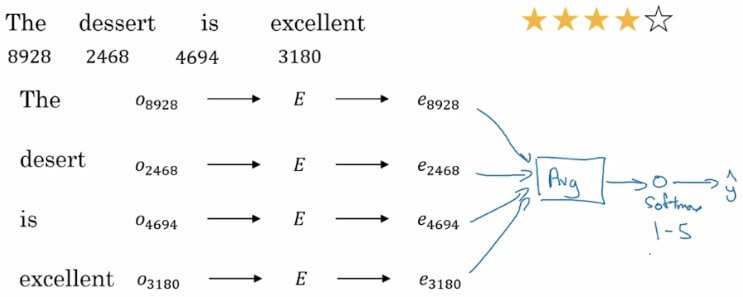
- 簡單的 Sentiment classification model 就這麼產生
- 將文字透過 one-hot vector 與 embedding matrix 結合
- 得到的 embedding vector 就是要 feed 進網路的 inputs
- 將所有的 vector elements 取平均
- 最後透過 softmax classifier 來取得 1-5 的分數,也就是預測的
- 這個簡單的 model 效果不錯,但有一個缺點
- 他沒有辦法分辨文字的前後順序
- 以這個句子來說,他看到太多 good,可能就把評分預測的很高
- 但實際上是非常低分的評價
RNN for Sentiment Classification
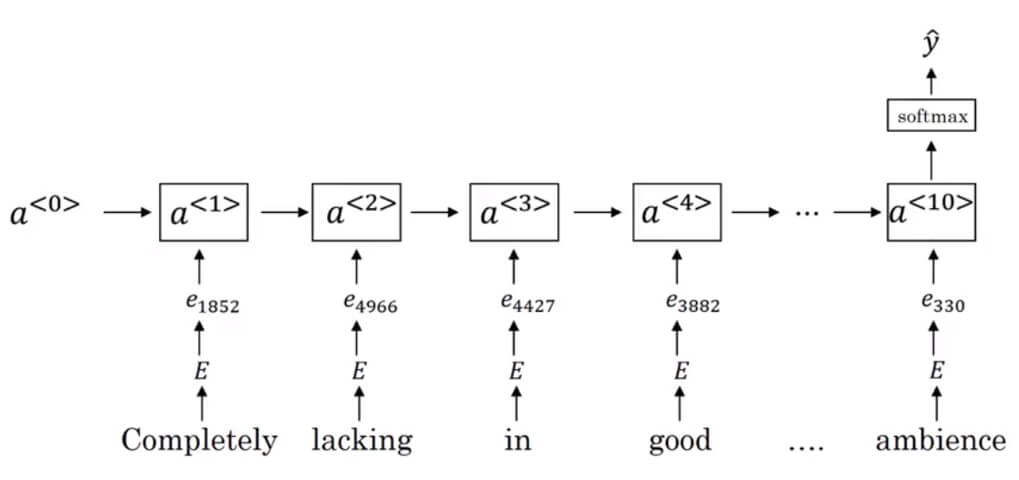
- 處理方式很簡單,將 embeddings 放入 RNN 訓練就好
- 一樣將 one-hot 轉成 embedding vectors
- 然後使用 one-to-many 的 RNN model
- 就可以得到有前後文意的 sentiment classification
Debiasing word embeddings
- 隨著越來越多地方使用 AI 當作決策依據
- AI 在訓練時更應該要避免掉種族、性別等歧視的 bias
- 很不幸的是,在進行 analogy reasoning 時就已經可以看到類似的情況產生
- 當
MantoComputer ProgrammerasWomanto "what" - 可以得到 HouseMaker 的答案,這很明顯是帶有性別歧視的答案
- 當
- 我們必須要消除這一類的偏見問題
- 首先要找出 bias direction
- 當 plot 出一些性別單字,如 girl, boy, she, he, mother, father ...
- 可以發現 babysitter 和 doctor 等單字也有相同的趨勢
- 我們先用一些方式 (e.g. SVD 分解) 來計算出該趨勢
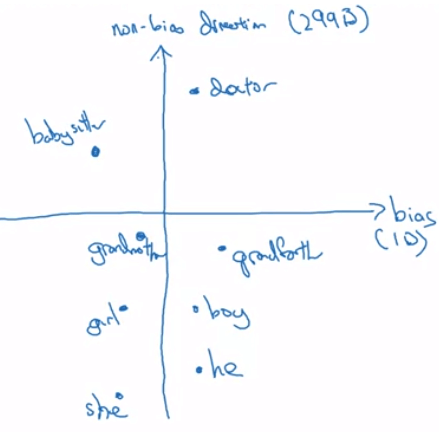
- Neuturalize bias
- 中和一些本身 (intrinsic) 不包含性別、種族的單字
- 例如 boy, girl 本身就代表了性別,所以不需中和
- 但 doctor, babysitter 這些詞需要中和其中的偏見
- 例如將他們拉至 non-bias direction 的線上
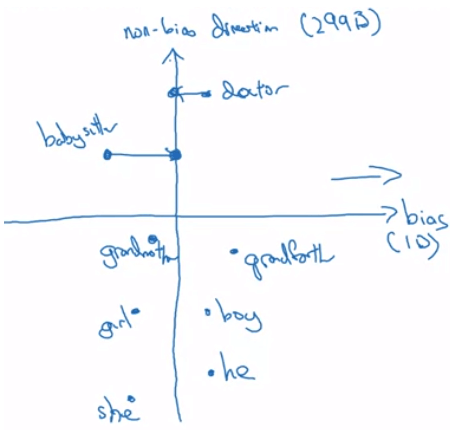
- Equalize pairs
- 此時 babysitter 看起來還是偏向女性一點
- 我們想確保 babysitter 和 grandmother, grandfather 的距離一致
- 於是我們用一些線性代數方式將 grandmother 或 grandfather 移動
- 最終使三者距離相等
